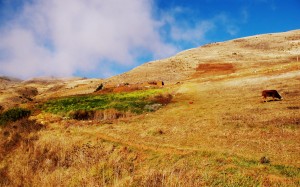 It was still dark at 6 a.m. when I gathered my things for the day and headed out shivering into the Cochabamba morning, bare toes waiting for the warmth of the sun. I met Jaime on the corner and we climbed in to the red, white, and blue “micro” bus, that would take us south to the main market, la cancha, that was already bustling with vendors setting up their mazes of second-hand clothing, stuffed animals, shoes.
It was still dark at 6 a.m. when I gathered my things for the day and headed out shivering into the Cochabamba morning, bare toes waiting for the warmth of the sun. I met Jaime on the corner and we climbed in to the red, white, and blue “micro” bus, that would take us south to the main market, la cancha, that was already bustling with vendors setting up their mazes of second-hand clothing, stuffed animals, shoes.
When I lived in this city for two years, I never would have breached that neighborhood before sunrise. It was an unnecessary danger, a lawless area between dusk and dawn, though many other women younger and older than I am were arriving to start their work. In contrast, I was on my way out of the city, away from work, to visit Totora, a small colonial town that everyone but I seemed to have visited.
Since returning to Cochabamba two months ago, I hadn’t left the city. Instead, I had slipped into a routine of arranging interviews, searching journal articles, seeing old friends, and climbing on Sundays. It was comforting to return to a place that I knew, and it made my interviews easier to accomplish and more substantive – I was interviewing many people who already new and trusted me for my work. At the same time, their trust increased my burden of responsibility. But leaving the city helped me to remember what drew me to understand farming in this place: little piles of neatly ordered straw, adobe houses that are as dusty as the road, steep hillsides protected by kewiña trees, potatoes and haba beans, a bike propped next to two cows grazing, the fog and smoke rising from an ancient lake basin of San Benito, thousands of little parcels divided into onions, wheat, fallow, peaches, eucalyptus – whatever the altitude, sun, pitch, soil, and water allows. A huge sign promises to eliminate fruit flies, a newly arrived agricultural pest in the fruit producing regions (“From Chile,” I’ve been told), and a Swiss development agency SUV roars by our overloaded, ancient station wagon. All symbols of progress, perhaps.
What is really being changed here is the water. In these rural homes, electricity arrived a few years ago. The adobe is not sealed (many windows do not even have glass) but small patches of bright green from yard-sized sprinkler systems are beginning to speckle the dry countryside.
Getting away from the urban environment where my research and agricultural organizations are located, I remember the practical side of doing this work, to make visible the political aspects of food systems and non-profit institutions, to recognize that not just the farmer defines the way he or she provides food, but that the whole production chain influences where and how food is grown in Bolivia.